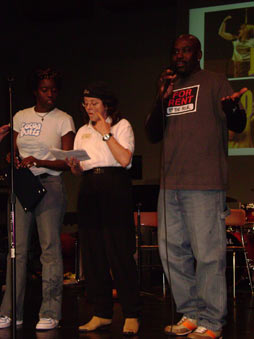By Montreal Spencer/reporter

With gas prices on the rise and the economy in almost anarchy, donating plasma can be a way for students to make extra money.
Several plasma donation sites in Tarrant County pay new donors $40 for the first two visits and about $30 for every visit after that.
Some students go just to get the money from the first two visits.
“I just went twice, and I got the 80 bucks. It’s cool as long as you don’t mind needles,” Tim Partin, South student, said.
Other students can really use the extra money and are more than happy to donate.
“I’ve been coming about five months,” Donovan Irvin, South student, said. “I needed a little extra money ’cause it’s hard finding a job that fits around your school schedule.”
Some students have even made donating a part of their weekly routine along with going to work and school.
“I went a few times to get a little extra change. With my being a single parent and going to school and work, some extra money doesn’t hurt,” Tanza Wilson, South student, said.
Before a donation can be made, a test for HIV and hepatitis is given.
The technicians at the center make sure there is no glucose in the urine because this would mean the possible donor has diabetes. They also check the blood pressure.
Plasma donating is a way for someone to know if he or she has health issues. While regular check ups are necessary, a trip to a plasma center could provide initial information about a health problem.
Contrary to popular belief, donating plasma does not harm a person’s health in any way.
“I found that giving plasma lowered my resting heart rate significantly, making it heart healthy,” Laura Green said on www.winona.edu/winonan.
If getting money is not enough, the fact in knowing plasma can help save lives is persuasive in its own right.
According to Green, “Plasma is the liquid protein contained in your blood, also known as the platelets. Hemophiliacs, the main recipients of a plasma donation, need approximately 600 bags twice a year to replenish their platelet count.”
Wilson said, “I know if I needed plasma, I would want someone to donate and help me. If I can help save a life, I’m wiling to make that contribution.”
If one chooses to donate plasma, ZLB Plasma Services provides the following tips.
Being well hydrated is essential for a timely donation. For adequate hydration, you should be drinking two-three liters of non-alcoholic (and preferably non-caffeinated) fluids per day.
Avoid alcohol and caffeine; they can contribute to dehydration.
Eat a well-balanced, low-fat meal within four hours of donating.
To avoid lipemic plasma (plasma with high fat content), stay away from high fat foods.
Overall good health is the key to a successful donation.
Try to get at least six-eight hours of sleep each night.
Maintain a healthy diet and adequate fluid intake, even when you’re not donating.
Avoid smoking in the one-two hours prior to your donation.
If you’re experiencing a lot of stress, it may be best to wait and donate on another day.
If you become ill, give your body adequate time to recover before you donate. Plasma contains antibodies and proteins necessary for you to get well.
After a donation, the donor should leave the bandage on his arm for at least 45 minutes.
The donor should also drink plenty of fluids in the 24 hours after the donation.



























